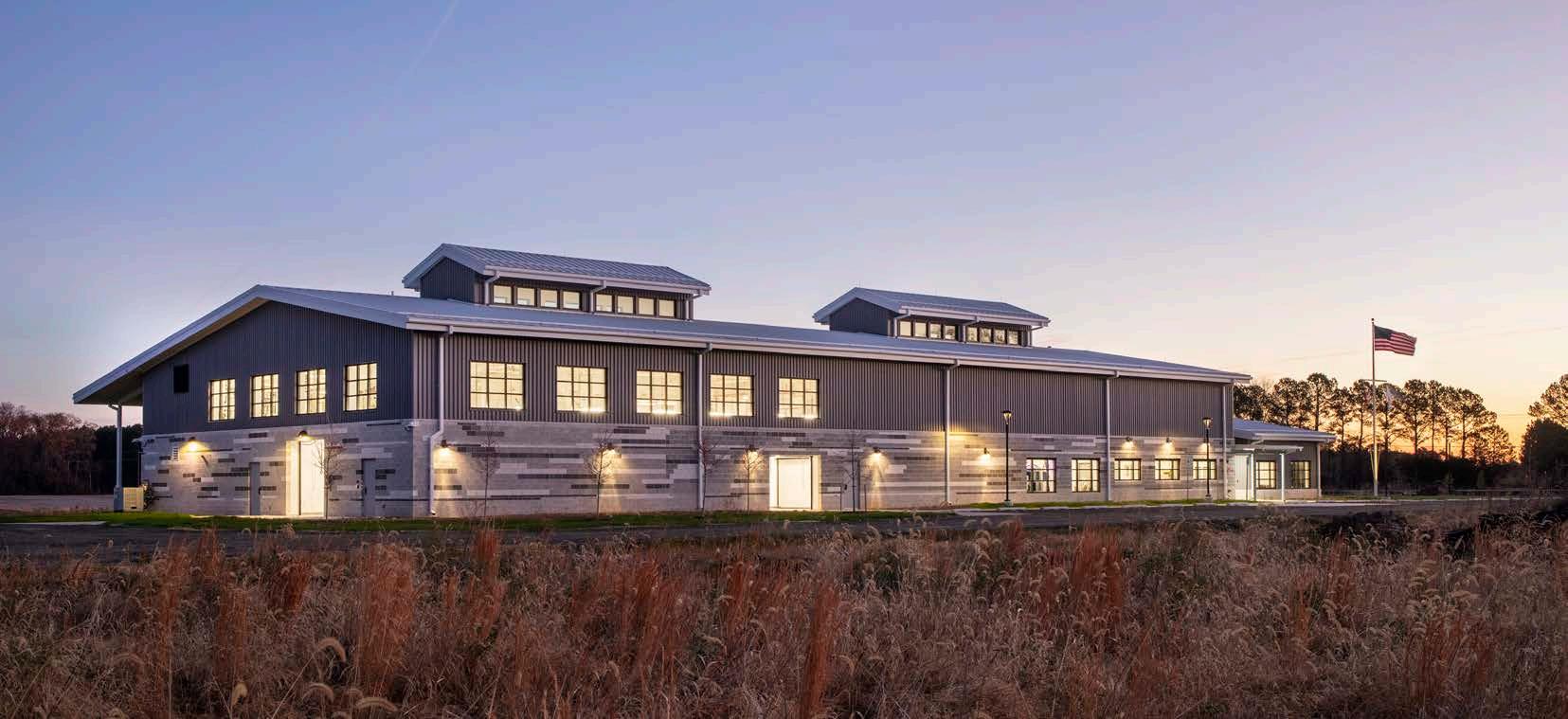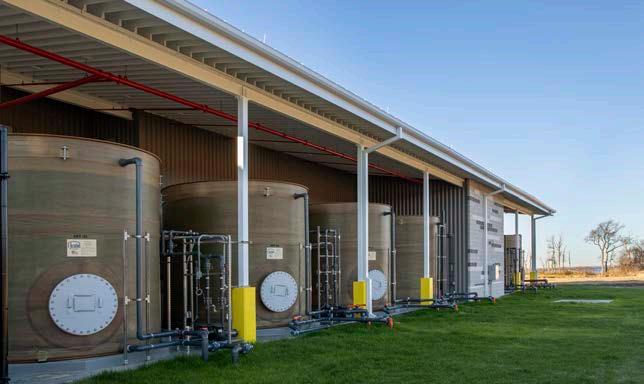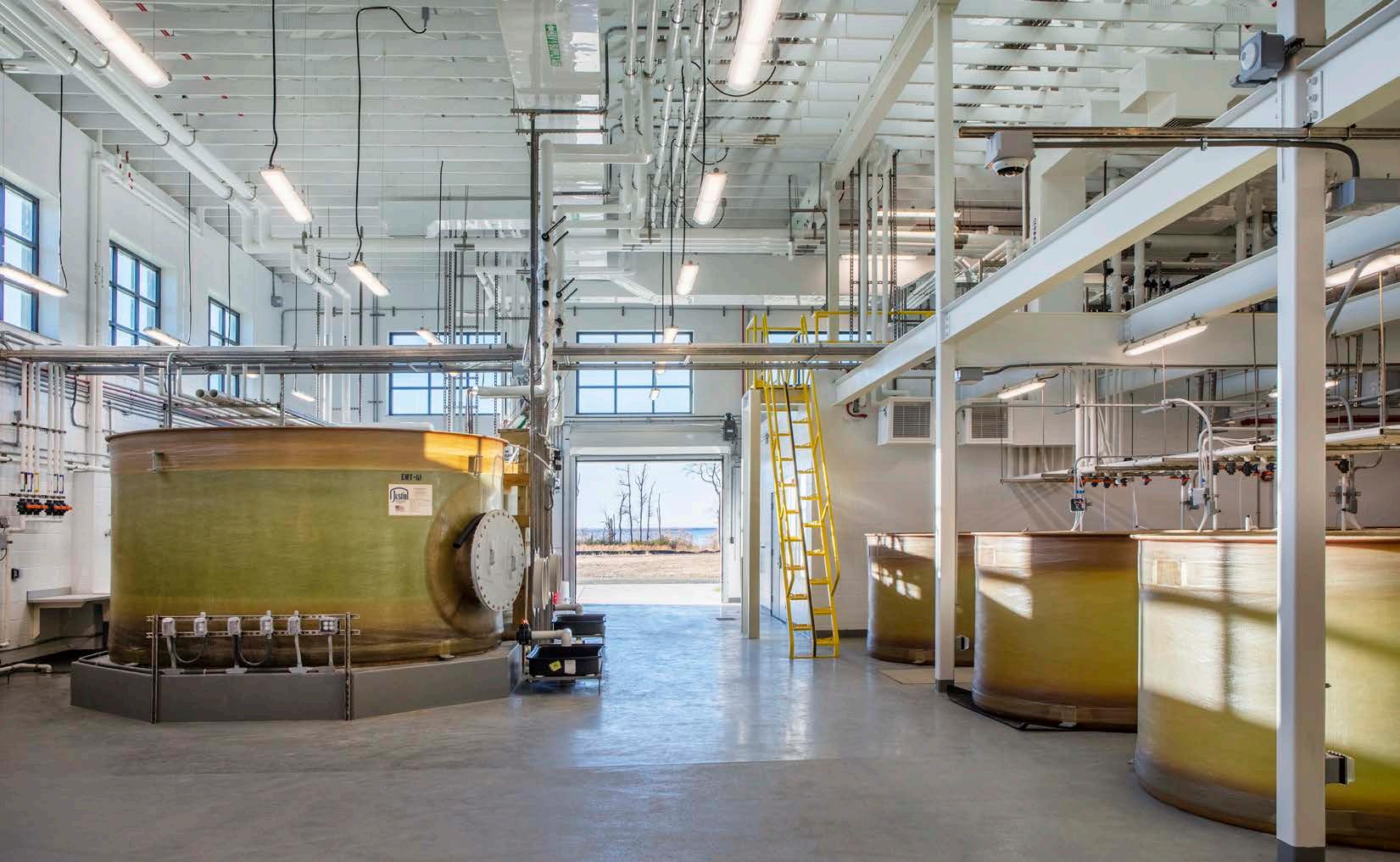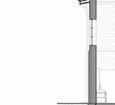Ferry Cove Oyster Hatchery
Ferry Cove was designed to become one of the largest hatcheries on the East Coast producing the Eastern Oyster (Crassostrea virginica). The facility takes advantage of its location on the Chesapeake Bay, the nation’s largest estuary, to blend commerce, natural resource protection, education, and research on coastal resiliency-related issues.
The 20,483 GSF building was built from the ground up to be a multi-faceted shellfish production facility. The unique computer control systems enable the facility to manipulate water salinity, temperature, pH, and algae, thereby providing maximum flexibility to mitigate the many environmental conditions that could impact production. The exterior hearkens back to the oyster shucking houses of the 1800s which used to border the Bay with clerestory windows providing amply light for processing.

An Inside Look at... Becker Morgan Group | Architecture & Engineering | Delaware • Maryland • North Carolina | www.beckermorgan.com
The facility uses Bay water & pumps it through multiple filtration systems before it enters the hatchery.
Ferry Cove Oyster Hatchery is situated on 70-acres with 2,000 feet of shoreline, native forest, two intertidal ponds, wetlands and fields for crop production. The building was sited to minimize environmental impact and maximize the natural resources of the property.


SITE PLAN
First Floor

The building was designed to be highly flexible to accommodate the various production environments that operators will face today and in years to come. The open floor plan with easy-to-access connection points enables easy cleaning and repairs, if needed. Building



Second Floor

FLOOR PLAN

Becker Morgan Group | Architecture & Engineering | Delaware • Maryland • North Carolina | www.beckermorgan.com
The facility’s purpose is not only to produce shellfish, but also to educate. Ferry Cove regularly hosts commercial watermen, aquaculturists, scientists and local community groups for educational and demonstration tours. The design team took this into consideration when it created the production and administrative flex space.


 Historic Precedents
Historic Precedents
FIRST FLOOR PLAN ELEV. 0" EQUIPMENT PLATFORM FLOOR ELEV. 12' 0" LABORATORY 120ALGAE PRODUCTION 122 SPAWNING 127 RECEIVING 126 Laboratory Algae Production








































Ferry Cove uses highly automated algae photo bioreactors (PBRs) for all its algae needs. These systems produce high-density cultures that are used throughout the oyster production process to feed the broodstock, eggs, larvae, and seed.



Broodstock
































The flexibility of the design enables oysters to be produced throughout most of the year, far beyond the natural spawning cycle of warm summer months. By increasing production of oyster larvae and seed, Ferry Cove will be able to dramatically increase the number of farm-raised oysters being grown in the Mid-Atlantic region. Oyster reefs also serve as a natural filter of the Bay’s waters, provide vital marine habitat, and help balance the Bay’s ecosystem.

FIRST FLOOR PLAN ELEV. 0" EQUIPMENT PLATFORM FLOOR ELEV. 12' 0" BROODSTOCK 124 AQUACULTURE EQUIP PLATFORM LARVAL REARING 123 ELEC. 116 MAINTENANCE ENGINEERING 117 AQ EQUIP ROOM 118 AQUACULTURE EQUIP PLATFORM 202 EMERG. 116A FIRE PUMP RM 115 MECH. PLATFORM 1 203
 Becker Morgan Group | Architecture & Engineering | Delaware • Maryland • North Carolina
Becker Morgan Group | Architecture & Engineering | Delaware • Maryland • North Carolina
| www.beckermorgan.com
The design of the facility’s aquaculture systems incorporated computer controls to monitor the hatchery’s operations on a 24x7 basis both on-site and remotely during the production season as well as to minimize the energy usage in heating and chilling the water used during the production process. To further minimize the potential for disruption during the production process, the facility has conditioned filtered water reserves as well as back-up generator.
Located in the historical epicenter of the wild commercial oyster fishery in Maryland’s portion of the Chesapeake Bay, the facility is located near many of the emerging oyster farms that are joining the Eastern Shore landscape. The striated design of the CMU walls, the color design and discharge pond shape that was used is representative of an oyster shell.

Conditioned Bay Water Reserves

































































































Brood Stock Water Controls & Feeding System


























































 Masonry Veneer
Masonry Veneer
Clerestories and large windows both within the production area and administrative space reduces the need for artificial lighting, conserves energy and improves psychological well-being of staff.





















 Egg Hatching and Larvae Rearing Tanks
Egg Hatching and Larvae Rearing Tanks
FIRST FLOOR PLAN ELEV. 0" EQUIPMENT PLATFORM FLOOR ELEV. 12' 0" SPAWNING 127 LARVAL REARING 123
 Becker Morgan Group | Architecture & Engineering | Delaware • Maryland • North Carolina | www.beckermorgan.com
Becker Morgan Group | Architecture & Engineering | Delaware • Maryland • North Carolina | www.beckermorgan.com
